Echinops ritro
Small globe thistle, Echinops ritro, is a perennial member of the Asteraceae family that includes sunflowers, daisies, globe artichokes, and asters. It is suited to cultivation in USDA Hardiness Zones 3 to 8.
Also called Southern globe thistle, this flower is native to Europe and Asia. Its most noteworthy features are its blue to blue-purple color, tall stature, and prickly foliage.
Cultivated varieties expand the color palette to include white.
The Echinops genus is a broad one containing many species, including the blue, E. bannaticus; great, E. sphaerocephalus; and tall, E. exaltatus, varieties.
The most noteworthy differences among them are color, size of the flower heads, and height.

We link to vendors to help you find relevant products. If you buy from one of our links, we may earn a commission.
Some are naturalized across the US, most notably E. sphaerocephalus, which is considered to be a noxious weed in Illinois.
Read on for everything you need to know to grow small globe thistle, E. ritro, in your gardens.
What You’ll Learn
Let’s get started!
Cultivation and History
Small globe thistle, aka Southern globe thistle, is a sturdy and attractive clumping plant.
Its compact, globe-like flower heads measure approximately one and a half to two inches across, or about the size of a golf ball. Each is made up of many tiny star-like blooms.
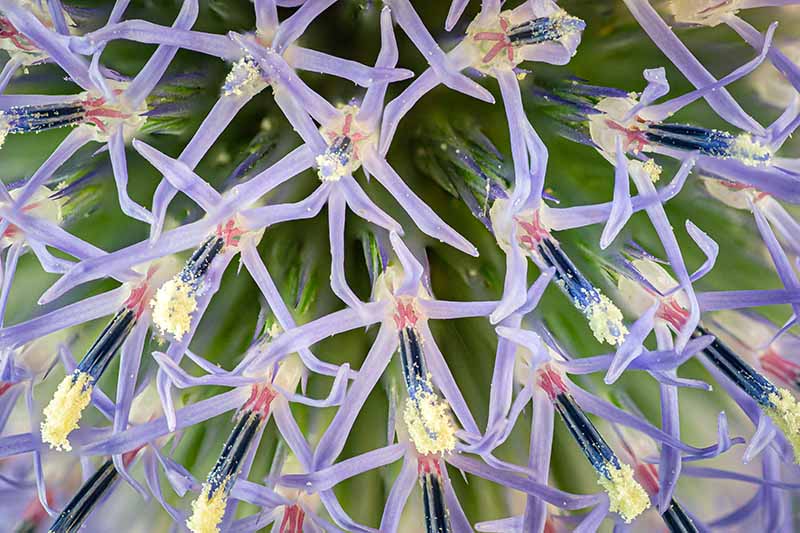
Flowers are available in shades of blue and white, and perch atop upright stems. The leaves are deeply serrated and gray-green. Mature heights range from 36 to 48 inches, and widths from 24 to 30 inches.
Be sure to wear gloves when handling plants because the foliage has prickly spines.
E. ritro is a mid to late summer bloomer.
Flower heads run to seed after blooming, and self-sow. Plants die to the ground with the first frost and return each spring. Clumps enlarge via root growth and self-sowing.

There is also a subspecies of E. rito, Echinops ritro subsp. ruthenicus. This is a slightly more compact blue-flowering plant. With heights of two to three feet, and widths of one and a half to two feet, it is best suited to Zones 4 to 8.
The word Echinops translates roughly to “hedgehog head” in Greek, which would, indeed, describe a prickly, spherical flower. That was likely just what Swedish botanist Charles Linneaus thought when he named the genus in the mid-1700s.
From garden cultivation abroad, Echinops made its way to America, where it was listed in the 1806 edition of American Gardener’s Calendar, written by the garden advisor to Thomas Jefferson, Bernard McMahon.
Herbal practitioners value the roots of Echinops for their anti-inflammatory and lactation-promoting properties.
Propagation
To grow this plant, start with seeds or root cuttings. Division is also possible, but challenging.
From Seed
Direct sow seeds in the spring after the last average frost date for your region.
Work the soil to a crumbly consistency to a depth of about 12 inches.
Moisten the soil and sprinkle a few seeds every 24 to 30 inches. When the seedlings have two sets of true leaves, you can thin them to one sturdy plant per interval.
Alternatively, start seeds indoors four to six weeks prior to the last frost date. Use biodegradable seed starter cells that can be transplanted in their entirety, to minimize root disruption.
Sow two to three seeds per seed starter cell. Maintain even moisture during germination, but don’t oversaturate.
When the seedlings have two sets of true leaves, thin them to one per cell.
After the danger of frost has passed, acclimate the seedlings to the outdoors for a few hours each day.
Leave the seedlings in the starter cells, as long as you used the type that biodegrade.
Space them at a distance of 24 to 30 inches.
Set them into the garden soil and cover them lightly, so the potting medium in the cell is even with the ground level.
From Root Cuttings
You can also start plants by taking cuttings from the lateral roots of an established plant during late winter to early spring dormancy.
Carefully dig four to six inches out from a plant clump to reveal roots that come out sideways from the center.
Choose a root and gradually unearth it by brushing away the soil above and below it.
From the thickest part of the root, cut a length of four or five inches.
Tamp the soil down back down over the rootstock of the main plant after you have taken your cutting.
Dip the cut ends of the root piece into rooting hormone powder, and bury the root horizontally about three inches deep in garden soil or container potting medium, in a location where they can receive full sun.
Water and maintain even moisture until established. Green growth is evidence of success.
By Division
You can also try to divide an existing plant in the spring or fall.
This is challenging because E. ritro has a long, thick taproot, and it’s hard to judge its length.
Dig up the entire plant, gently loosening the soil around it as you go, and lifting it out of the ground.
Brush off the soil and examine the roots. You should see a taproot and fibrous side roots.
Slice down through the taproot so that each portion divided contains some taproot and one or more “eyes,” the points from which the fibrous roots grow.
Replant the divisions to the same depth.
If you inadvertently sever the taproot during the unearthing, the part that’s still in the ground will most likely regenerate. However, divisions may not have enough root stock attached to grow successfully.
How to Grow
Find a location with full sun. Light afternoon shade is tolerated. Try to make this a permanent location, as transplanting may damage the long taproot.
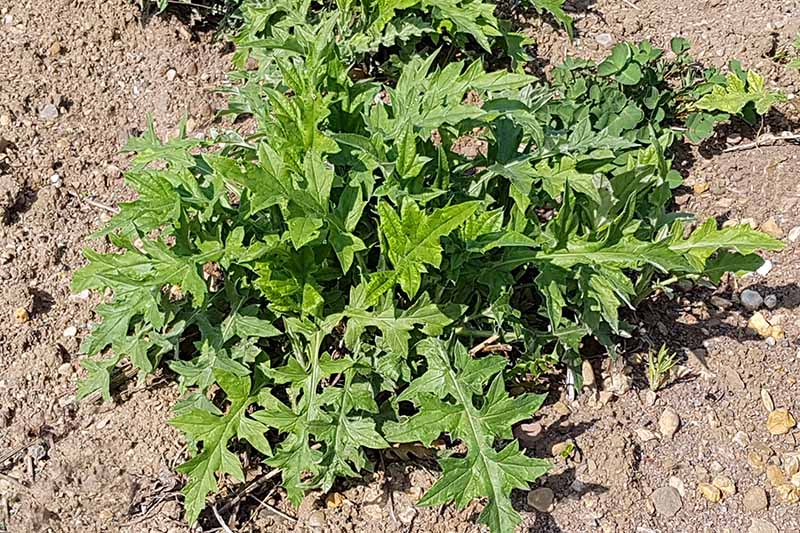
E. ritro prefers average to poor soil that is dry and drains well. The ideal pH is slightly acidic to neutral, between 5.5 and 7.0. In soil that is too fertile and wet, growth may become leggy, with too much foliage and too few flowers.
To learn the composition of your soil, conduct a soil test through your local agricultural extension.
For both sown seeds and transplanted seedlings, water after planting, and provide an inch of water per week while plants become established.
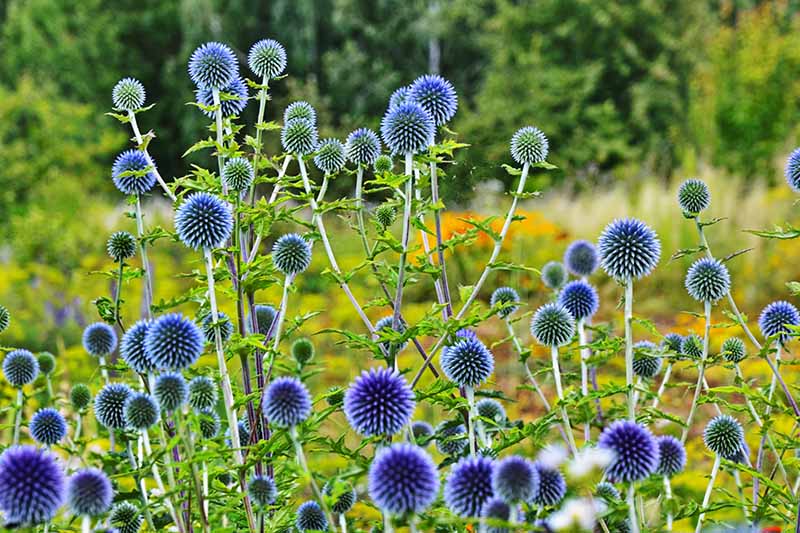
Thereafter, unless there is a prolonged dry spell, supplemental watering is not necessary.
For container gardening, choose a pot with good drainage holes that measures 24 to 30 inches wide and 18 to 24 inches deep, to accommodate mature dimensions and roots.
E. ritro tolerates salt and drought once established.
Growing Tips
- Choose a permanent location to avoid stress to the taproot.
- If starting seeds indoors, use biodegradable seed starter cells to avoid taproot damage during transplant.
- Maintain even moisture during germination.
- Once established, plants require little water.
Pruning and Maintenance
Small globe thistle is not only attractive, it’s low maintenance, too.
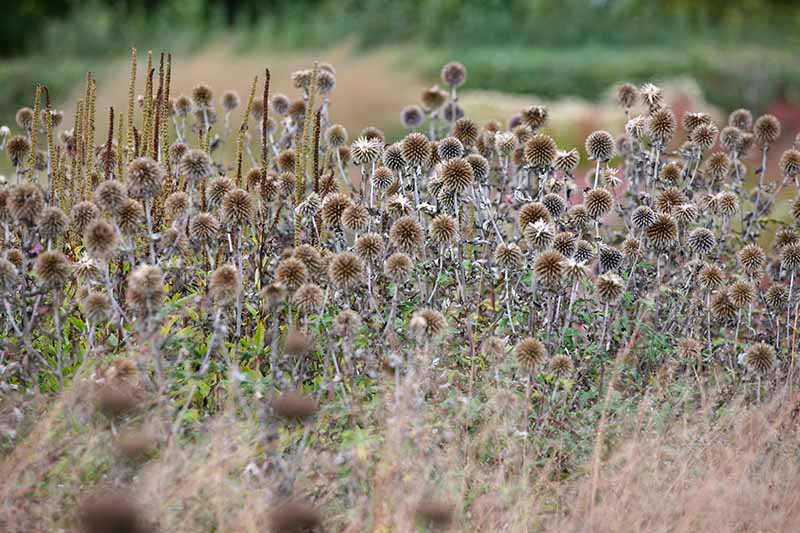
During the growing season, deadhead spent flowers by cutting stems just above a pair of leaves, to encourage a second bloom.
Water in the event of a prolonged dry spell.
Stake tall plants as needed to prevent them from bending and breaking. Broken stems are not only unattractive, they are vulnerable to pests and disease.
Weed the garden regularly to minimize competition for water, maintain optimal airflow, deter pests, and inhibit fungal growth.
To limit self-sowing, remove all flower heads as they begin to fade, before they turn brown and set seed.
In the fall, after the first frost, cut all stems to the ground and dispose of the debris, to inhibit the wintering over of pests and pathogens.
In the spring, you can allow self-sown seedlings to grow, or remove them. You can try to transplant them, but remember the taproot is easily damaged.
Cultivars to Select
When shopping for E. ritro, you will find mostly blue flowers, but white is also available. Seeds and bare rootstock are both available for purchase.
One of the brightest, most popular cultivars is ‘Veitch’s Blue.’
It has deep violet-blue spherical flower heads atop 24- to 36-inch gray-green stems that appear silver in the sunshine. Enjoy a second bloom with deadheading.
With a spread of 18 to 24 inches across, plants form substantial clumps for a robust addition to the garden. Give it room to self-sow and enjoy a field of blue!
Find ‘Veitch’s Blue’ bare roots available now from Spring Hill Nurseries via Home Depot.
Managing Pests and Disease
Small globe thistle is not particularly prone to pests and disease.
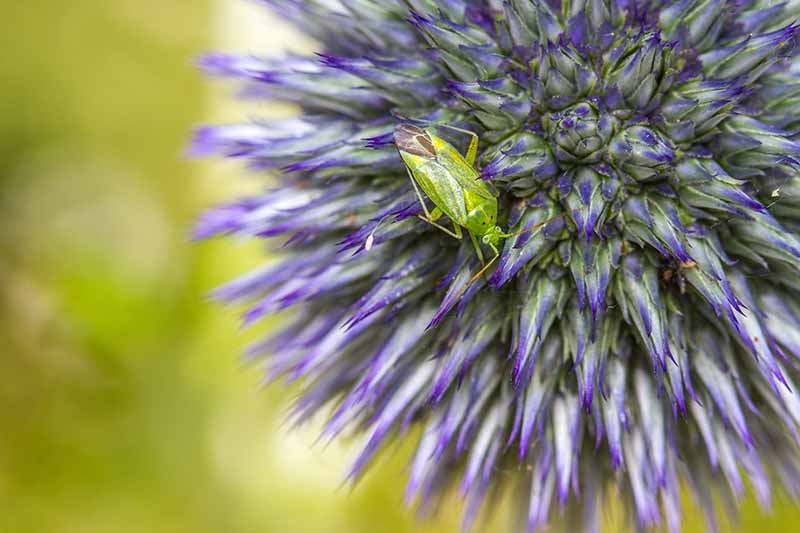
However, there are some pests to watch for, including:
- Aphid
- Echinops Leaf Miner
- Four Lined Plant Bug
- Potato Capsid Bug
The aphid, four lined plant bug, and potato capsid bug are sap-suckers that feed on plant juices, causing foliar deformity, discoloration, and desiccation.
Remove affected foliage. Pick off the bugs and drop them into a bucket of soapsuds, or dislodge them with a firm spray of water. To treat a persistent infestation, apply organic neem oil.
The larvae of the Echinops leaf miner burrows into foliage, feeding from within, and disfiguring leaves. Remove affected foliage and treat as needed with neem oil. You can find more information on leaf miner control here.
All of these pests cause damage that is unattractive, but not fatal, and may have no effect on the flowers.
As for disease, be aware of:
Crown rot is a potentially lethal disease caused by a soilborne fungus that destroys plant tissue at the crown level, where the stems meet the roots.
If plants are rotting from the bottom up, remove and destroy them to avoid spreading this disease.
Powdery mildew is a fungal condition that appears as a furry gray growth on the foliage, and is unlikely to appear unless conditions are excessively wet. Remove affected foliage and treat plants with a fungicide.
In addition to having minimal pest and disease problems, this prickly beauty does not appeal to herbivores like deer and rabbits.
Best Uses
The modest water needs of E. ritro once it is established, and its exceptional drought tolerance, make it a practical choice for xeriscaping, in which plants thrive with minimal care and moisture supplementation.
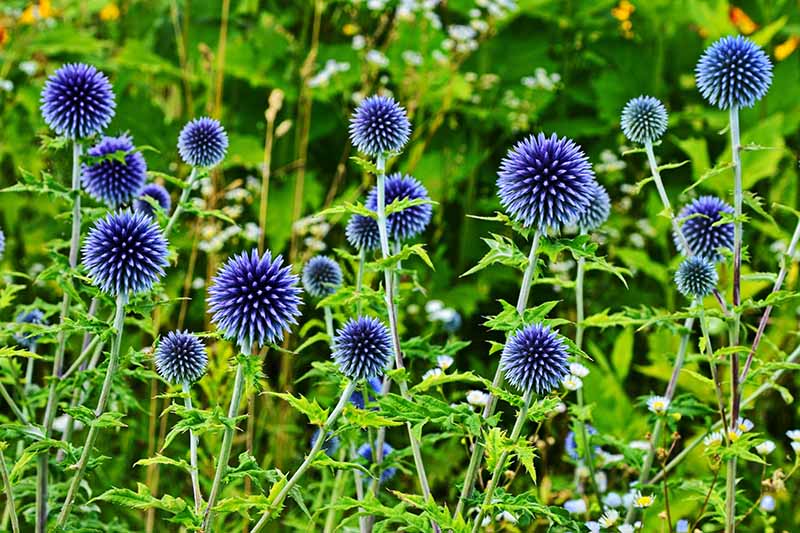
Also salt tolerant once established, and at home in shallow, dry soil, this is also a good plant for windswept coastal locales.
In mixed beds, borders, and containers, small globe thistle adds vertical interest with its tall lines, a rounded form with its spherical blooms, and rich texture with its prickly foliage.
As an anchor for shorter foundation plantings, its whimsical globes are unexpected and eye-catching.
Use its shades of blue in contrast with flowers in shades of orange that share similar cultural requirements, such as black-eyed Susan, coneflower, globe amaranth, and yarrow.
White varieties play well with flora or all colors, and function as a refreshing palate cleanser between hot summer reds and oranges.
They’re also fun in white flower gardens as their white globes seem to glow and float on air in the early evening hours.
And why not create a cutting garden?
This sturdy flower just begs to be cut for fresh as well as dry floral arrangements.
Arranging foliage from the garden is fun for the whole family.
Please see our article on growing anise hyssop for harvesting and drying instructions. It’s an easy process that involves simply bundling what you’ve cut, and hanging the bundles upside down to dry.
Quick Reference Growing Guide
| Plant Type: | Herbaceous perennial | Flower / Foliage Color: | Blue /gray green |
| Native to: | Asia, Europe | Tolerance: | Deer, drought, dry soil, rabbits, rocky soil, salt, shallow soil |
| Hardiness (USDA Zone): | 3-8 | Soil Type: | Average to dry, low fertility |
| Bloom Time: | Mid to late summer | Soil pH: | 5.5-7.0 |
| Exposure: | Full sun | Soil Drainage: | Well-draining |
| Spacing: | 24-30 inches | Attracts: | Bees, butterflies, and other beneficial insects |
| Planting Depth: | Surface sow | Companion Planting: | Black-eyed Susan, coneflower, globe amaranth, yarrow |
| Height: | 36-48 inches | Uses: | Beds, borders, containers, cutting gardens, rockeries, xeriscapes |
| Spread: | 24-30 inches | Order: | Asterales |
| Water Needs: | Low | Family: | Asteraceae |
| Maintenance | Low | Genus: | Echinops |
| Common Pests and Diseases: | Aphid, Echipnops leaf miner, four lined plant bug, potato capsid bug; crown rot, powdery mildew | Species: | Ritro |
A Cut and Dried Winner
With its preference for average to poor soil, minimal water, low maintenance requirements, and few pest or disease issues, small globe thistle is an exceptional perennial.
Add to that the whimsical form, texture, and tall lines it brings to the garden, as well as both fresh and dry arrangements, and we have a plant that’s a true winner!
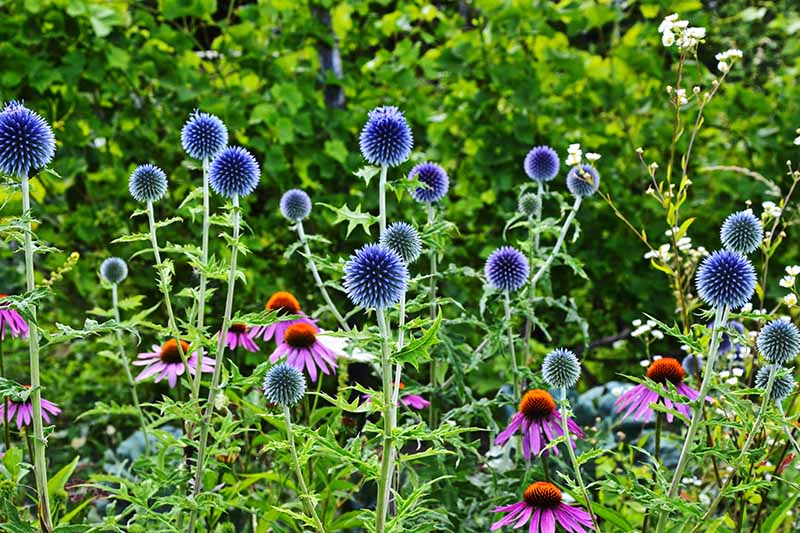
Add this species to your garden planner, and enjoy it in your summer landscape for years to come.
Are you growing small globe thistle in your garden? Let us know in the comments section below!
And for more information on growing more aster family flowers in your landscape, check out these guides next:

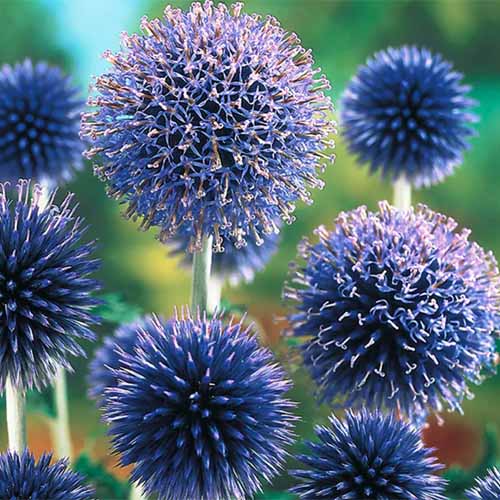
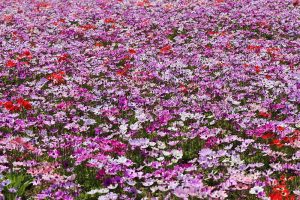
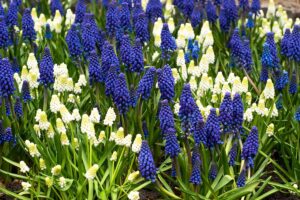

Amazing Flower!
cute!